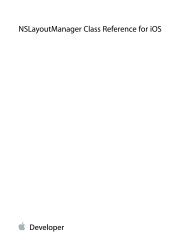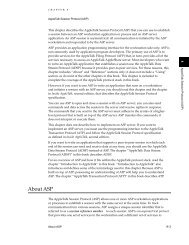URL Loading System Programming Guide - Apple Developer
URL Loading System Programming Guide - Apple Developer
URL Loading System Programming Guide - Apple Developer
You also want an ePaper? Increase the reach of your titles
YUMPU automatically turns print PDFs into web optimized ePapers that Google loves.
Life Cycle of a <strong>URL</strong> Session<br />
Life Cycle of a <strong>URL</strong> Session with Custom Delegates<br />
If the task failed, most apps should retry the request until either the user cancels the download or the<br />
server returns an error indicating that the request will never succeed. Your app should not retry immediately,<br />
however. Instead, it should use reachability APIs to determine whether the server is reachable, and should<br />
make a new request only when it receives a notification that reachability has changed.<br />
If the download task can be resumed, the NSError object’s userInfo dictionary contains a value for the<br />
NS<strong>URL</strong>SessionDownloadTaskResumeData key. Your app should pass this value to call<br />
downloadTaskWithResumeData: or downloadTaskWithResumeData:completionHandler: to<br />
create a new download task that continues the existing download.<br />
If the task cannot be resumed, your app should create a new download task and restart the transaction<br />
from the beginning.<br />
In either case, if the transfer failed for any reason other than a server error, go to step 3 (creating and<br />
resuming task objects).<br />
Note: NS<strong>URL</strong>Session does not report server errors through the error parameter. The only<br />
errors your delegate receives through the error parameter are client-side errors, such as being<br />
unable to resolve the hostname or connect to the host. The error codes are described in <strong>URL</strong><br />
<strong>Loading</strong> <strong>System</strong> Error Codes.<br />
Server-side errors are reported through the HTTP status code in the NSHTTP<strong>URL</strong>Response<br />
object. For more information, read the documentation for the NSHTTP<strong>URL</strong>Response and<br />
NS<strong>URL</strong>Response classes.<br />
14. If the response is multipart encoded, the session may call the delegate’s didReceiveResponse method<br />
again, followed by zero or more additional didReceiveData calls. If this happens, go to step 7 (handling<br />
the didReceiveResponse call).<br />
15. When you no longer need a session, invalidate it by calling either invalidateAndCancel (to cancel<br />
outstanding tasks) or finishTasksAndInvalidate (to allow outstanding tasks to finish before invalidating<br />
the object).<br />
After invalidating the session, when all outstanding tasks have been canceled or have finished, the session<br />
sends the delegate a <strong>URL</strong>Session:didBecomeInvalidWithError: message. When that delegate<br />
method returns, the session disposes of its strong reference to the delegate.<br />
Important: The session object keeps a strong reference to the delegate until your app explicitly<br />
invalidates the session. If you do not invalidate the session, your app leaks memory.<br />
If your app cancels an in-progress download, the NS<strong>URL</strong>Session object calls the delegate’s<br />
<strong>URL</strong>Session:task:didCompleteWithError: method as though an error occurred.<br />
2013-10-22 | Copyright © 2003, 2013 <strong>Apple</strong> Inc. All Rights Reserved.<br />
69
















